Airworthiness: Regulations, Certifications, and Case Study Analysis
VerifiedAdded on 2023/04/25
|27
|7604
|410
Report
AI Summary
This report comprehensively examines the concept of airworthiness within the aviation industry, emphasizing its crucial role in ensuring safe and secure operations. It delves into the requirements for both initial and continuous airworthiness, referencing key regulations such as Part 21, Part M, and various subparts, along with certifications like Type Certificates and Air Operator Certificates. The report outlines the roles of organizations like ICAO, FAA, and EASA, and discusses the impact of Airworthiness Directives and Service Bulletins. Furthermore, it analyzes the effects of certifications and explores a case study, American Flight 96, highlighting the importance of technical innovations and system development in enhancing aviation safety. The report concludes by emphasizing the significance of airworthiness in maintaining the integrity and efficiency of the aviation sector.
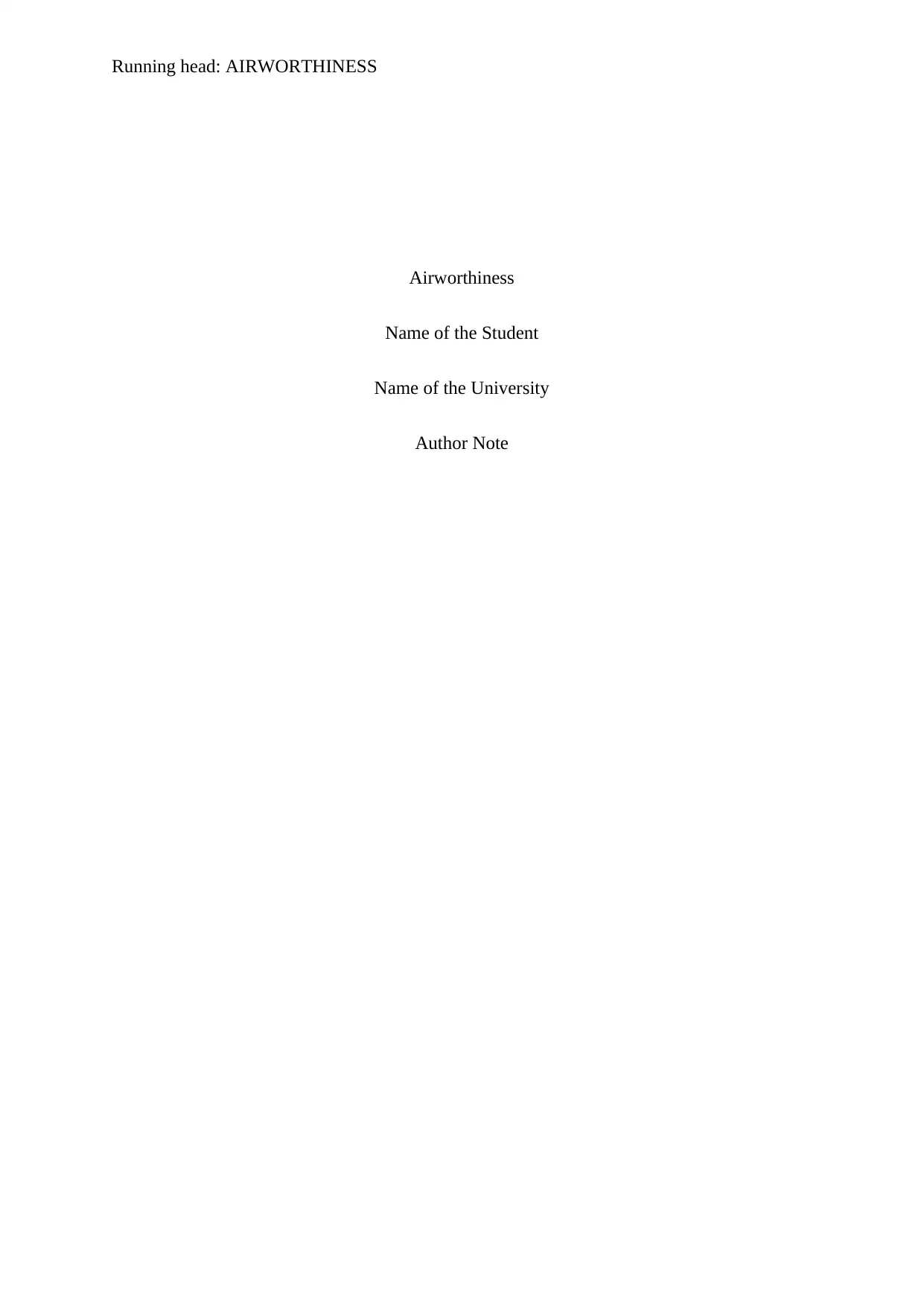
Running head: AIRWORTHINESS
Airworthiness
Name of the Student
Name of the University
Author Note
Airworthiness
Name of the Student
Name of the University
Author Note
Paraphrase This Document
Need a fresh take? Get an instant paraphrase of this document with our AI Paraphraser
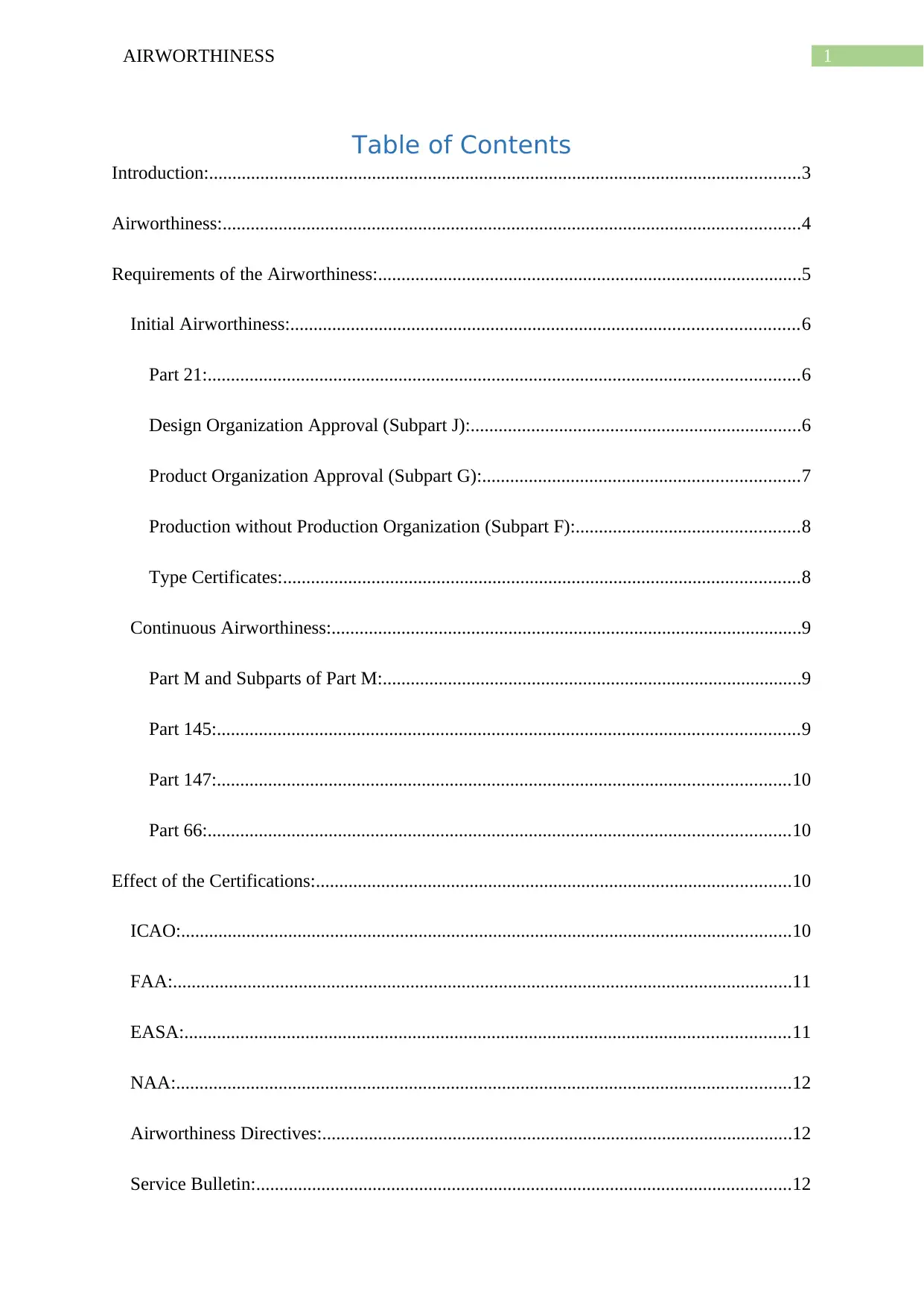
1AIRWORTHINESS
Table of Contents
Introduction:...............................................................................................................................3
Airworthiness:............................................................................................................................4
Requirements of the Airworthiness:...........................................................................................5
Initial Airworthiness:.............................................................................................................6
Part 21:...............................................................................................................................6
Design Organization Approval (Subpart J):.......................................................................6
Product Organization Approval (Subpart G):....................................................................7
Production without Production Organization (Subpart F):................................................8
Type Certificates:...............................................................................................................8
Continuous Airworthiness:.....................................................................................................9
Part M and Subparts of Part M:..........................................................................................9
Part 145:.............................................................................................................................9
Part 147:...........................................................................................................................10
Part 66:.............................................................................................................................10
Effect of the Certifications:......................................................................................................10
ICAO:...................................................................................................................................10
FAA:.....................................................................................................................................11
EASA:..................................................................................................................................11
NAA:....................................................................................................................................12
Airworthiness Directives:.....................................................................................................12
Service Bulletin:...................................................................................................................12
Table of Contents
Introduction:...............................................................................................................................3
Airworthiness:............................................................................................................................4
Requirements of the Airworthiness:...........................................................................................5
Initial Airworthiness:.............................................................................................................6
Part 21:...............................................................................................................................6
Design Organization Approval (Subpart J):.......................................................................6
Product Organization Approval (Subpart G):....................................................................7
Production without Production Organization (Subpart F):................................................8
Type Certificates:...............................................................................................................8
Continuous Airworthiness:.....................................................................................................9
Part M and Subparts of Part M:..........................................................................................9
Part 145:.............................................................................................................................9
Part 147:...........................................................................................................................10
Part 66:.............................................................................................................................10
Effect of the Certifications:......................................................................................................10
ICAO:...................................................................................................................................10
FAA:.....................................................................................................................................11
EASA:..................................................................................................................................11
NAA:....................................................................................................................................12
Airworthiness Directives:.....................................................................................................12
Service Bulletin:...................................................................................................................12
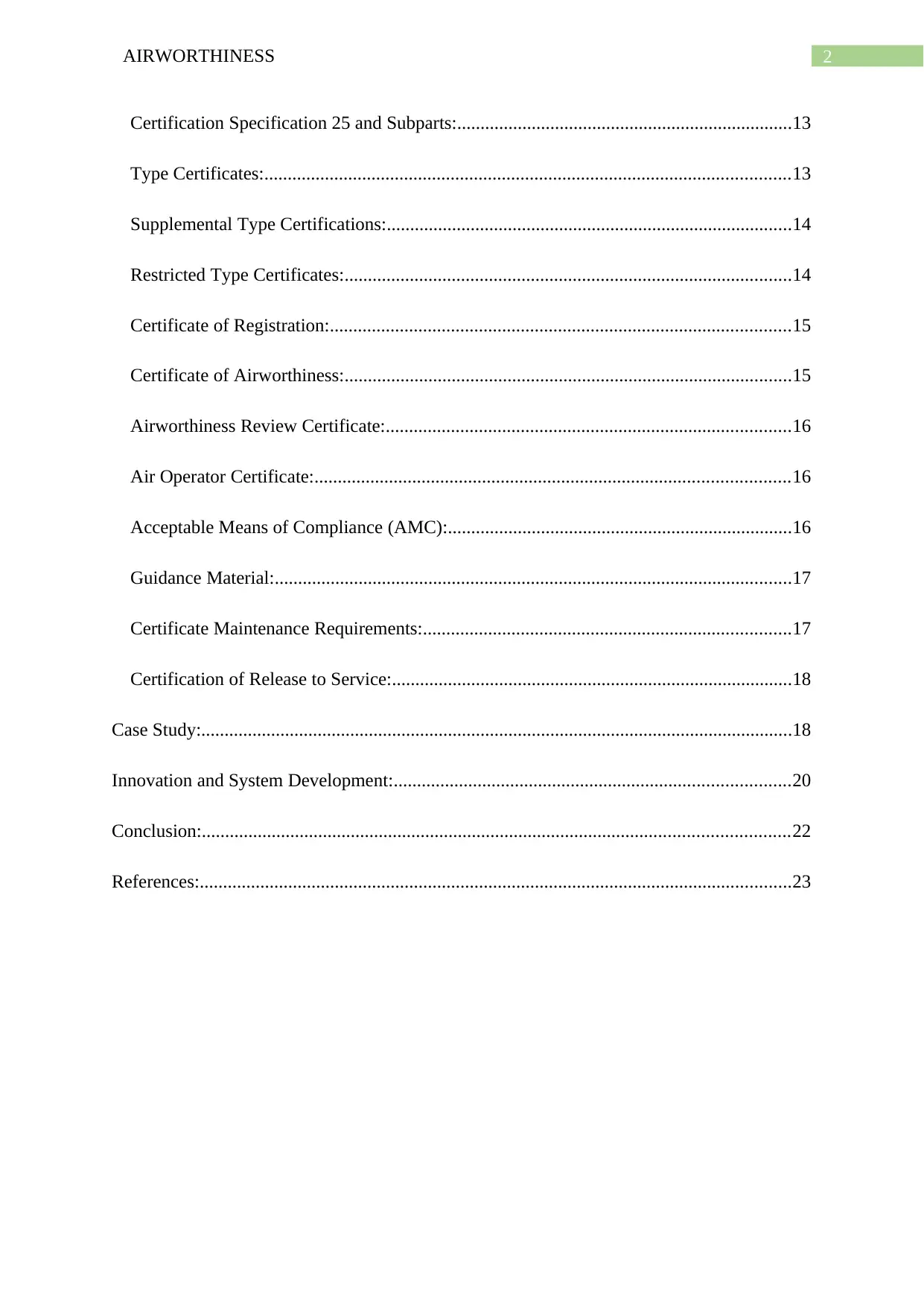
2AIRWORTHINESS
Certification Specification 25 and Subparts:........................................................................13
Type Certificates:.................................................................................................................13
Supplemental Type Certifications:.......................................................................................14
Restricted Type Certificates:................................................................................................14
Certificate of Registration:...................................................................................................15
Certificate of Airworthiness:................................................................................................15
Airworthiness Review Certificate:.......................................................................................16
Air Operator Certificate:......................................................................................................16
Acceptable Means of Compliance (AMC):..........................................................................16
Guidance Material:...............................................................................................................17
Certificate Maintenance Requirements:...............................................................................17
Certification of Release to Service:......................................................................................18
Case Study:...............................................................................................................................18
Innovation and System Development:.....................................................................................20
Conclusion:..............................................................................................................................22
References:...............................................................................................................................23
Certification Specification 25 and Subparts:........................................................................13
Type Certificates:.................................................................................................................13
Supplemental Type Certifications:.......................................................................................14
Restricted Type Certificates:................................................................................................14
Certificate of Registration:...................................................................................................15
Certificate of Airworthiness:................................................................................................15
Airworthiness Review Certificate:.......................................................................................16
Air Operator Certificate:......................................................................................................16
Acceptable Means of Compliance (AMC):..........................................................................16
Guidance Material:...............................................................................................................17
Certificate Maintenance Requirements:...............................................................................17
Certification of Release to Service:......................................................................................18
Case Study:...............................................................................................................................18
Innovation and System Development:.....................................................................................20
Conclusion:..............................................................................................................................22
References:...............................................................................................................................23
⊘ This is a preview!⊘
Do you want full access?
Subscribe today to unlock all pages.

Trusted by 1+ million students worldwide

3AIRWORTHINESS
Introduction:
The modern aviation industry is seen to be significantly profitable with the increment
in the number of the customers. The sales of the organizations operating in the mentioned
industry is increasing in a significant manner and that is seen to have a significant impact on
the organizations operating in the mentioned industry. The increment in the customers has
influenced many of the organizations in considering their plan of entering the aviation
market. The significant amount of opportunity that the organizations of the mentioned
industry are subjected, is observed to be crucial in increasing the competition of the market
with the entry of many of the new organisations. In spite of having a profitable market for
their business, many of the organizations are observed to face the heat of the competition. In
order to overcome the impact of the competition, the organizations are observed to be
focused in the application of the improved quality in their operations and the competitive
pricing policy (Moreno-Izquierdo, Ramón-Rodríguez and Ribes 2015).
In the aviation industry, the safe and secure operations of the organizations is to be
one of the key factor that influences the consumption of the customers and the preferences of
the customers in selecting a particular airlines for travelling. As the safe and secure travelling
is seen to be notably important for the customers of the mentioned industry, the organizations
operating in the mentioned industry is seen to focus on the safety of the customers in a
significant manner. This becomes pretty evident with the increment of the incorporation of
the technology and the innovative solutions in the safety requirements of the aviation
operations from the part of the organizations. Airworthiness is observed to be a key concept
in the safe and secure operations of the organizations operating in the aviation industry. The
conceptual definition of the term “Airworthiness” states that it is the degree of suitability of
the aircrafts for the safe flights (Shaw 2016). The increasing awareness of the customers
Introduction:
The modern aviation industry is seen to be significantly profitable with the increment
in the number of the customers. The sales of the organizations operating in the mentioned
industry is increasing in a significant manner and that is seen to have a significant impact on
the organizations operating in the mentioned industry. The increment in the customers has
influenced many of the organizations in considering their plan of entering the aviation
market. The significant amount of opportunity that the organizations of the mentioned
industry are subjected, is observed to be crucial in increasing the competition of the market
with the entry of many of the new organisations. In spite of having a profitable market for
their business, many of the organizations are observed to face the heat of the competition. In
order to overcome the impact of the competition, the organizations are observed to be
focused in the application of the improved quality in their operations and the competitive
pricing policy (Moreno-Izquierdo, Ramón-Rodríguez and Ribes 2015).
In the aviation industry, the safe and secure operations of the organizations is to be
one of the key factor that influences the consumption of the customers and the preferences of
the customers in selecting a particular airlines for travelling. As the safe and secure travelling
is seen to be notably important for the customers of the mentioned industry, the organizations
operating in the mentioned industry is seen to focus on the safety of the customers in a
significant manner. This becomes pretty evident with the increment of the incorporation of
the technology and the innovative solutions in the safety requirements of the aviation
operations from the part of the organizations. Airworthiness is observed to be a key concept
in the safe and secure operations of the organizations operating in the aviation industry. The
conceptual definition of the term “Airworthiness” states that it is the degree of suitability of
the aircrafts for the safe flights (Shaw 2016). The increasing awareness of the customers
Paraphrase This Document
Need a fresh take? Get an instant paraphrase of this document with our AI Paraphraser
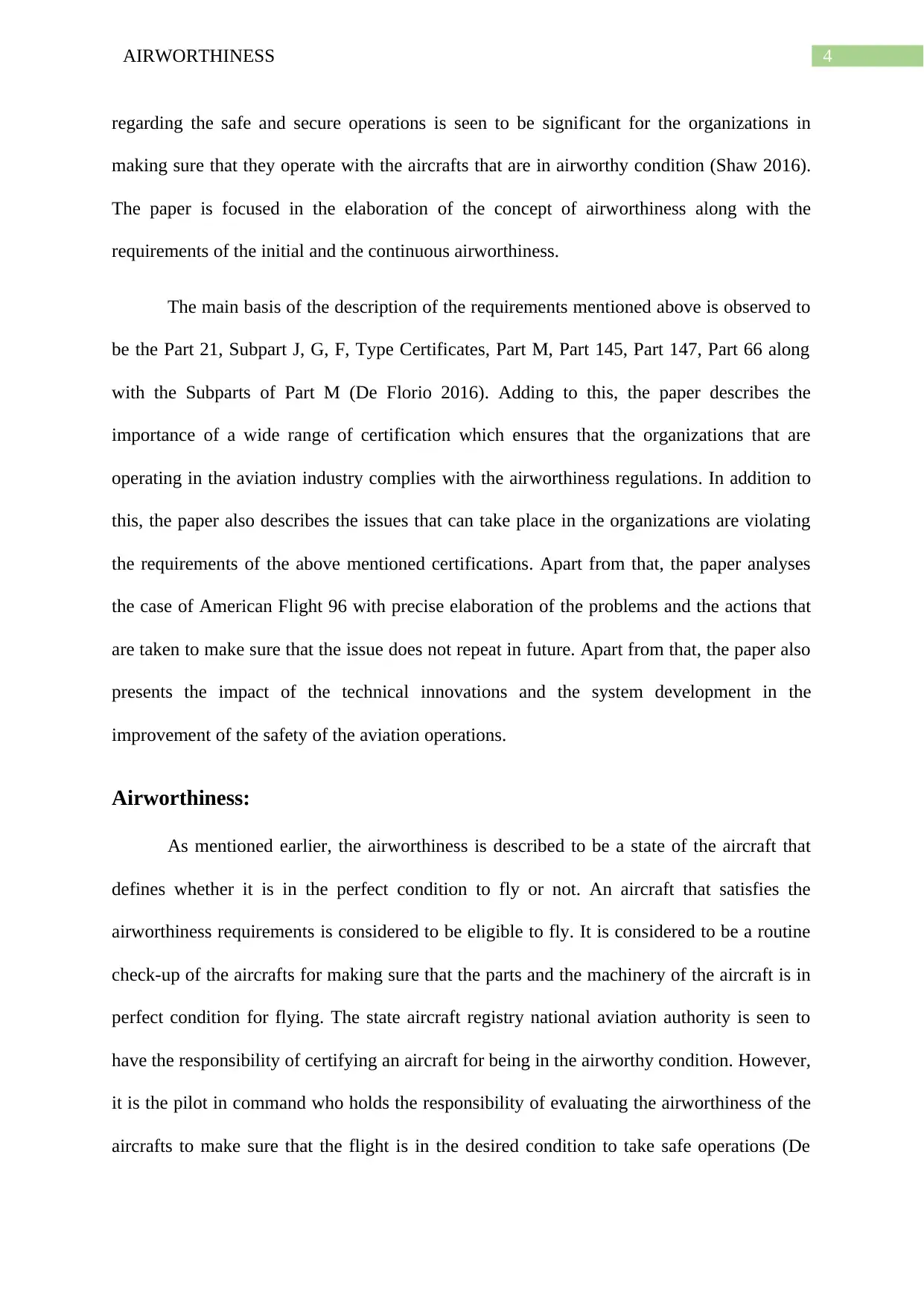
4AIRWORTHINESS
regarding the safe and secure operations is seen to be significant for the organizations in
making sure that they operate with the aircrafts that are in airworthy condition (Shaw 2016).
The paper is focused in the elaboration of the concept of airworthiness along with the
requirements of the initial and the continuous airworthiness.
The main basis of the description of the requirements mentioned above is observed to
be the Part 21, Subpart J, G, F, Type Certificates, Part M, Part 145, Part 147, Part 66 along
with the Subparts of Part M (De Florio 2016). Adding to this, the paper describes the
importance of a wide range of certification which ensures that the organizations that are
operating in the aviation industry complies with the airworthiness regulations. In addition to
this, the paper also describes the issues that can take place in the organizations are violating
the requirements of the above mentioned certifications. Apart from that, the paper analyses
the case of American Flight 96 with precise elaboration of the problems and the actions that
are taken to make sure that the issue does not repeat in future. Apart from that, the paper also
presents the impact of the technical innovations and the system development in the
improvement of the safety of the aviation operations.
Airworthiness:
As mentioned earlier, the airworthiness is described to be a state of the aircraft that
defines whether it is in the perfect condition to fly or not. An aircraft that satisfies the
airworthiness requirements is considered to be eligible to fly. It is considered to be a routine
check-up of the aircrafts for making sure that the parts and the machinery of the aircraft is in
perfect condition for flying. The state aircraft registry national aviation authority is seen to
have the responsibility of certifying an aircraft for being in the airworthy condition. However,
it is the pilot in command who holds the responsibility of evaluating the airworthiness of the
aircrafts to make sure that the flight is in the desired condition to take safe operations (De
regarding the safe and secure operations is seen to be significant for the organizations in
making sure that they operate with the aircrafts that are in airworthy condition (Shaw 2016).
The paper is focused in the elaboration of the concept of airworthiness along with the
requirements of the initial and the continuous airworthiness.
The main basis of the description of the requirements mentioned above is observed to
be the Part 21, Subpart J, G, F, Type Certificates, Part M, Part 145, Part 147, Part 66 along
with the Subparts of Part M (De Florio 2016). Adding to this, the paper describes the
importance of a wide range of certification which ensures that the organizations that are
operating in the aviation industry complies with the airworthiness regulations. In addition to
this, the paper also describes the issues that can take place in the organizations are violating
the requirements of the above mentioned certifications. Apart from that, the paper analyses
the case of American Flight 96 with precise elaboration of the problems and the actions that
are taken to make sure that the issue does not repeat in future. Apart from that, the paper also
presents the impact of the technical innovations and the system development in the
improvement of the safety of the aviation operations.
Airworthiness:
As mentioned earlier, the airworthiness is described to be a state of the aircraft that
defines whether it is in the perfect condition to fly or not. An aircraft that satisfies the
airworthiness requirements is considered to be eligible to fly. It is considered to be a routine
check-up of the aircrafts for making sure that the parts and the machinery of the aircraft is in
perfect condition for flying. The state aircraft registry national aviation authority is seen to
have the responsibility of certifying an aircraft for being in the airworthy condition. However,
it is the pilot in command who holds the responsibility of evaluating the airworthiness of the
aircrafts to make sure that the flight is in the desired condition to take safe operations (De

5AIRWORTHINESS
Florio 2016). According to the, Code of Federal Regulations in United States, Title 14,
Subchapter F, Part 91.7, the pilot in command has the responsibility of disrupting the
operations of the aircrafts in any case where it is identified that the structural, mechanical and
electrical condition of the aircrafts do not satisfy the airworthiness requirements for the safe
operations (Govinfo.gov. 2019).
The role of the International Civil Aviation Organization is seen to be significant in
the specification of the legislations regarding the airworthiness of the aircrafts (Icao.int.
2019). The Chicago convention of the mentioned organization was seen to produce the
legislation for the identification of the airworthiness. The designed legislation was of great
significance in defining the airworthiness in terms of the propeller, engine and the other parts
of the aircrafts. The evaluation of the status of the propeller, engine and the other parts of the
aircrafts regarding the construction of them in accordance to the approved design and the
maintenance of the parts which needs to satisfy the airworthiness of the aircrafts, are
considered to be major areas of focus of the designed legislation. The legislations designed
for the evaluation of the airworthiness also covers the aspect of using the aircrafts in the
approved standards and the limitations. The legislation of the airworthiness also focuses in
making sure that the aircrafts are functioned by the certified operators who has achieved
certification regarding the operations from the certified organizations and the operations of
them is considered to be accepted by the state of the aircraft registry (De Florio 2016).
Requirements of the Airworthiness:
The requirements which are in need to be maintained for the airworthy operations of
the aircrafts are observed to be divided into two different parts which are initial airworthiness
and the continuous airworthiness.
Florio 2016). According to the, Code of Federal Regulations in United States, Title 14,
Subchapter F, Part 91.7, the pilot in command has the responsibility of disrupting the
operations of the aircrafts in any case where it is identified that the structural, mechanical and
electrical condition of the aircrafts do not satisfy the airworthiness requirements for the safe
operations (Govinfo.gov. 2019).
The role of the International Civil Aviation Organization is seen to be significant in
the specification of the legislations regarding the airworthiness of the aircrafts (Icao.int.
2019). The Chicago convention of the mentioned organization was seen to produce the
legislation for the identification of the airworthiness. The designed legislation was of great
significance in defining the airworthiness in terms of the propeller, engine and the other parts
of the aircrafts. The evaluation of the status of the propeller, engine and the other parts of the
aircrafts regarding the construction of them in accordance to the approved design and the
maintenance of the parts which needs to satisfy the airworthiness of the aircrafts, are
considered to be major areas of focus of the designed legislation. The legislations designed
for the evaluation of the airworthiness also covers the aspect of using the aircrafts in the
approved standards and the limitations. The legislation of the airworthiness also focuses in
making sure that the aircrafts are functioned by the certified operators who has achieved
certification regarding the operations from the certified organizations and the operations of
them is considered to be accepted by the state of the aircraft registry (De Florio 2016).
Requirements of the Airworthiness:
The requirements which are in need to be maintained for the airworthy operations of
the aircrafts are observed to be divided into two different parts which are initial airworthiness
and the continuous airworthiness.
⊘ This is a preview!⊘
Do you want full access?
Subscribe today to unlock all pages.

Trusted by 1+ million students worldwide
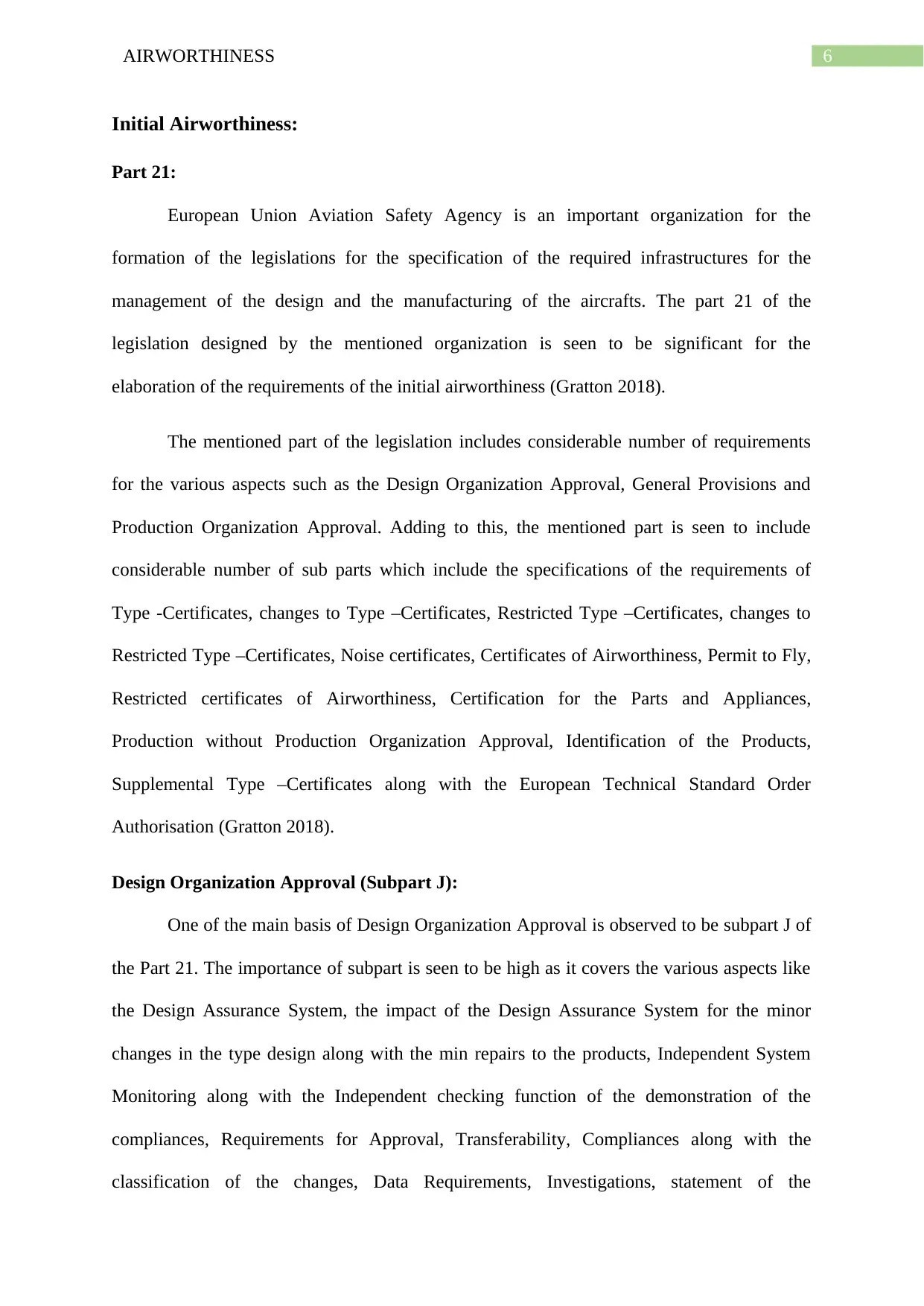
6AIRWORTHINESS
Initial Airworthiness:
Part 21:
European Union Aviation Safety Agency is an important organization for the
formation of the legislations for the specification of the required infrastructures for the
management of the design and the manufacturing of the aircrafts. The part 21 of the
legislation designed by the mentioned organization is seen to be significant for the
elaboration of the requirements of the initial airworthiness (Gratton 2018).
The mentioned part of the legislation includes considerable number of requirements
for the various aspects such as the Design Organization Approval, General Provisions and
Production Organization Approval. Adding to this, the mentioned part is seen to include
considerable number of sub parts which include the specifications of the requirements of
Type -Certificates, changes to Type –Certificates, Restricted Type –Certificates, changes to
Restricted Type –Certificates, Noise certificates, Certificates of Airworthiness, Permit to Fly,
Restricted certificates of Airworthiness, Certification for the Parts and Appliances,
Production without Production Organization Approval, Identification of the Products,
Supplemental Type –Certificates along with the European Technical Standard Order
Authorisation (Gratton 2018).
Design Organization Approval (Subpart J):
One of the main basis of Design Organization Approval is observed to be subpart J of
the Part 21. The importance of subpart is seen to be high as it covers the various aspects like
the Design Assurance System, the impact of the Design Assurance System for the minor
changes in the type design along with the min repairs to the products, Independent System
Monitoring along with the Independent checking function of the demonstration of the
compliances, Requirements for Approval, Transferability, Compliances along with the
classification of the changes, Data Requirements, Investigations, statement of the
Initial Airworthiness:
Part 21:
European Union Aviation Safety Agency is an important organization for the
formation of the legislations for the specification of the required infrastructures for the
management of the design and the manufacturing of the aircrafts. The part 21 of the
legislation designed by the mentioned organization is seen to be significant for the
elaboration of the requirements of the initial airworthiness (Gratton 2018).
The mentioned part of the legislation includes considerable number of requirements
for the various aspects such as the Design Organization Approval, General Provisions and
Production Organization Approval. Adding to this, the mentioned part is seen to include
considerable number of sub parts which include the specifications of the requirements of
Type -Certificates, changes to Type –Certificates, Restricted Type –Certificates, changes to
Restricted Type –Certificates, Noise certificates, Certificates of Airworthiness, Permit to Fly,
Restricted certificates of Airworthiness, Certification for the Parts and Appliances,
Production without Production Organization Approval, Identification of the Products,
Supplemental Type –Certificates along with the European Technical Standard Order
Authorisation (Gratton 2018).
Design Organization Approval (Subpart J):
One of the main basis of Design Organization Approval is observed to be subpart J of
the Part 21. The importance of subpart is seen to be high as it covers the various aspects like
the Design Assurance System, the impact of the Design Assurance System for the minor
changes in the type design along with the min repairs to the products, Independent System
Monitoring along with the Independent checking function of the demonstration of the
compliances, Requirements for Approval, Transferability, Compliances along with the
classification of the changes, Data Requirements, Investigations, statement of the
Paraphrase This Document
Need a fresh take? Get an instant paraphrase of this document with our AI Paraphraser

7AIRWORTHINESS
qualifications and experiences, Terms of Approval, Procedure for the implementation of the
minor changes and the Type design along with minor repairs, effective management of the
significant changes in the Design Assurance System, Procedure for the approval of the
conditions for issuing the permit to fly, method for the approval of the minor revisions in the
manual of the aircraft flight, issuing of the information and instructions along with the
specification of the method for the approval of the conditions for issuing a permit to fly
(Easa.europa.eu 2019).
Product Organization Approval (Subpart G):
The main basis of the Product Organization Approval is observed to be the subpart G
of the Part 21 of the legislation designed by EASA. The subpart is seen to include various
clauses for the effective management of the scope of the Applicable Design Data, Quality
Systems and the different features of the Quality systems, strong bond between the
production organizations and the design organizations and the requirements of an approval.
Adding to this, the subpart also specifies the requirements for the operations such as the
Independent Quality Assurance Systems, Monitoring functions, Approval requirements
regarding the airworthiness, the evaluation of the vendor and subcontractor, Production
Organization Exposition, effective management of the impact of the noise, fuel venting with
a precise focus on the exhaust emissions, the certification of the pay party suppliers,
certification of the employees, controlling and audit of the operations along with the
Evidence Authorisation (Easa.europa.eu. 2019).
Apart from this, the list of the activities governed by the mentioned subpart also
includes the specification regarding the terms of approval and the techniques for the effective
and efficient management of the changes in the terms of approval, the speciation of the
condition for the safe operations along with the verification of the satisfactory control.
Adding to this, the subpart also elaborates the operations of the POA holders with a precise
qualifications and experiences, Terms of Approval, Procedure for the implementation of the
minor changes and the Type design along with minor repairs, effective management of the
significant changes in the Design Assurance System, Procedure for the approval of the
conditions for issuing the permit to fly, method for the approval of the minor revisions in the
manual of the aircraft flight, issuing of the information and instructions along with the
specification of the method for the approval of the conditions for issuing a permit to fly
(Easa.europa.eu 2019).
Product Organization Approval (Subpart G):
The main basis of the Product Organization Approval is observed to be the subpart G
of the Part 21 of the legislation designed by EASA. The subpart is seen to include various
clauses for the effective management of the scope of the Applicable Design Data, Quality
Systems and the different features of the Quality systems, strong bond between the
production organizations and the design organizations and the requirements of an approval.
Adding to this, the subpart also specifies the requirements for the operations such as the
Independent Quality Assurance Systems, Monitoring functions, Approval requirements
regarding the airworthiness, the evaluation of the vendor and subcontractor, Production
Organization Exposition, effective management of the impact of the noise, fuel venting with
a precise focus on the exhaust emissions, the certification of the pay party suppliers,
certification of the employees, controlling and audit of the operations along with the
Evidence Authorisation (Easa.europa.eu. 2019).
Apart from this, the list of the activities governed by the mentioned subpart also
includes the specification regarding the terms of approval and the techniques for the effective
and efficient management of the changes in the terms of approval, the speciation of the
condition for the safe operations along with the verification of the satisfactory control.
Adding to this, the subpart also elaborates the operations of the POA holders with a precise
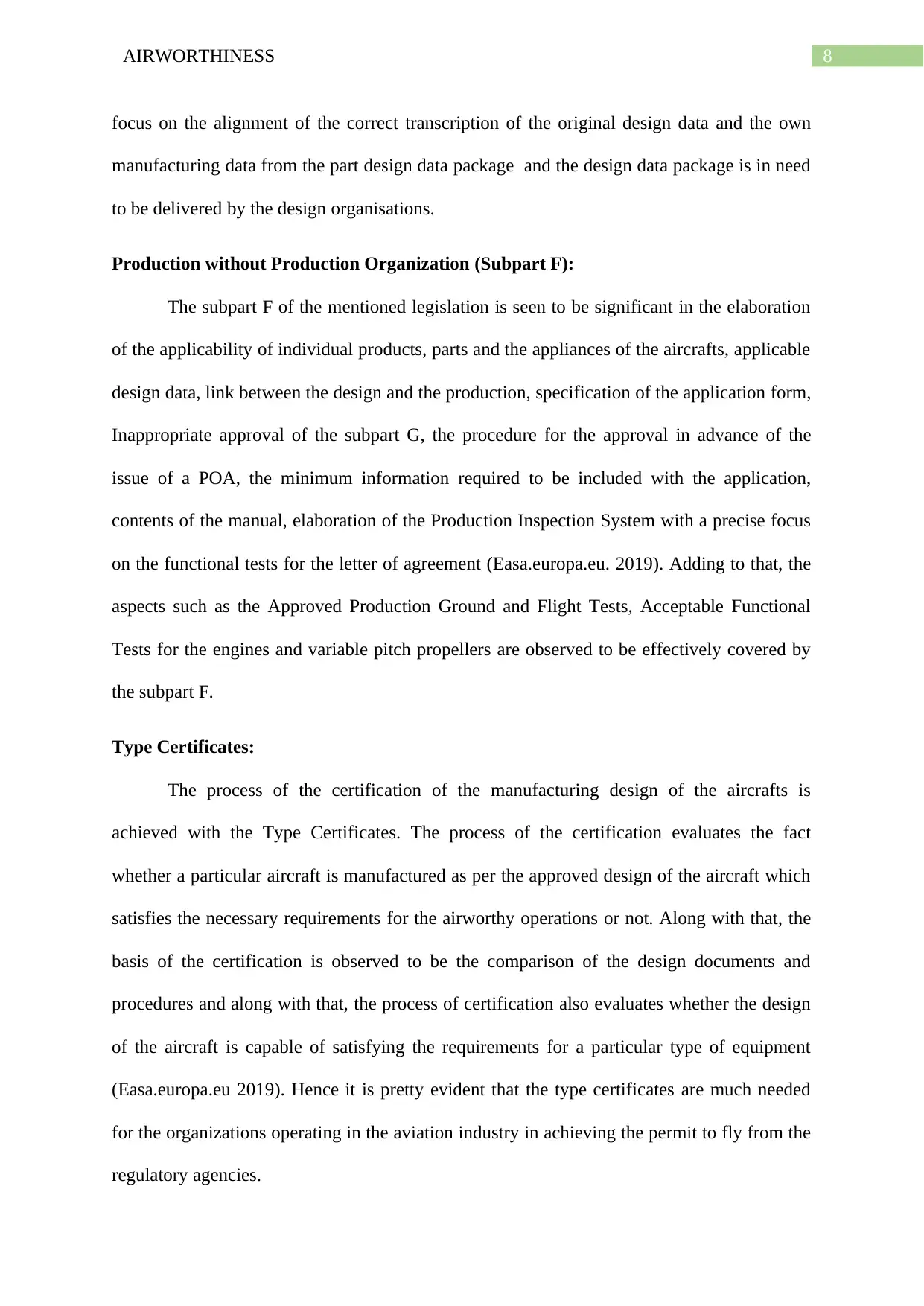
8AIRWORTHINESS
focus on the alignment of the correct transcription of the original design data and the own
manufacturing data from the part design data package and the design data package is in need
to be delivered by the design organisations.
Production without Production Organization (Subpart F):
The subpart F of the mentioned legislation is seen to be significant in the elaboration
of the applicability of individual products, parts and the appliances of the aircrafts, applicable
design data, link between the design and the production, specification of the application form,
Inappropriate approval of the subpart G, the procedure for the approval in advance of the
issue of a POA, the minimum information required to be included with the application,
contents of the manual, elaboration of the Production Inspection System with a precise focus
on the functional tests for the letter of agreement (Easa.europa.eu. 2019). Adding to that, the
aspects such as the Approved Production Ground and Flight Tests, Acceptable Functional
Tests for the engines and variable pitch propellers are observed to be effectively covered by
the subpart F.
Type Certificates:
The process of the certification of the manufacturing design of the aircrafts is
achieved with the Type Certificates. The process of the certification evaluates the fact
whether a particular aircraft is manufactured as per the approved design of the aircraft which
satisfies the necessary requirements for the airworthy operations or not. Along with that, the
basis of the certification is observed to be the comparison of the design documents and
procedures and along with that, the process of certification also evaluates whether the design
of the aircraft is capable of satisfying the requirements for a particular type of equipment
(Easa.europa.eu 2019). Hence it is pretty evident that the type certificates are much needed
for the organizations operating in the aviation industry in achieving the permit to fly from the
regulatory agencies.
focus on the alignment of the correct transcription of the original design data and the own
manufacturing data from the part design data package and the design data package is in need
to be delivered by the design organisations.
Production without Production Organization (Subpart F):
The subpart F of the mentioned legislation is seen to be significant in the elaboration
of the applicability of individual products, parts and the appliances of the aircrafts, applicable
design data, link between the design and the production, specification of the application form,
Inappropriate approval of the subpart G, the procedure for the approval in advance of the
issue of a POA, the minimum information required to be included with the application,
contents of the manual, elaboration of the Production Inspection System with a precise focus
on the functional tests for the letter of agreement (Easa.europa.eu. 2019). Adding to that, the
aspects such as the Approved Production Ground and Flight Tests, Acceptable Functional
Tests for the engines and variable pitch propellers are observed to be effectively covered by
the subpart F.
Type Certificates:
The process of the certification of the manufacturing design of the aircrafts is
achieved with the Type Certificates. The process of the certification evaluates the fact
whether a particular aircraft is manufactured as per the approved design of the aircraft which
satisfies the necessary requirements for the airworthy operations or not. Along with that, the
basis of the certification is observed to be the comparison of the design documents and
procedures and along with that, the process of certification also evaluates whether the design
of the aircraft is capable of satisfying the requirements for a particular type of equipment
(Easa.europa.eu 2019). Hence it is pretty evident that the type certificates are much needed
for the organizations operating in the aviation industry in achieving the permit to fly from the
regulatory agencies.
⊘ This is a preview!⊘
Do you want full access?
Subscribe today to unlock all pages.

Trusted by 1+ million students worldwide
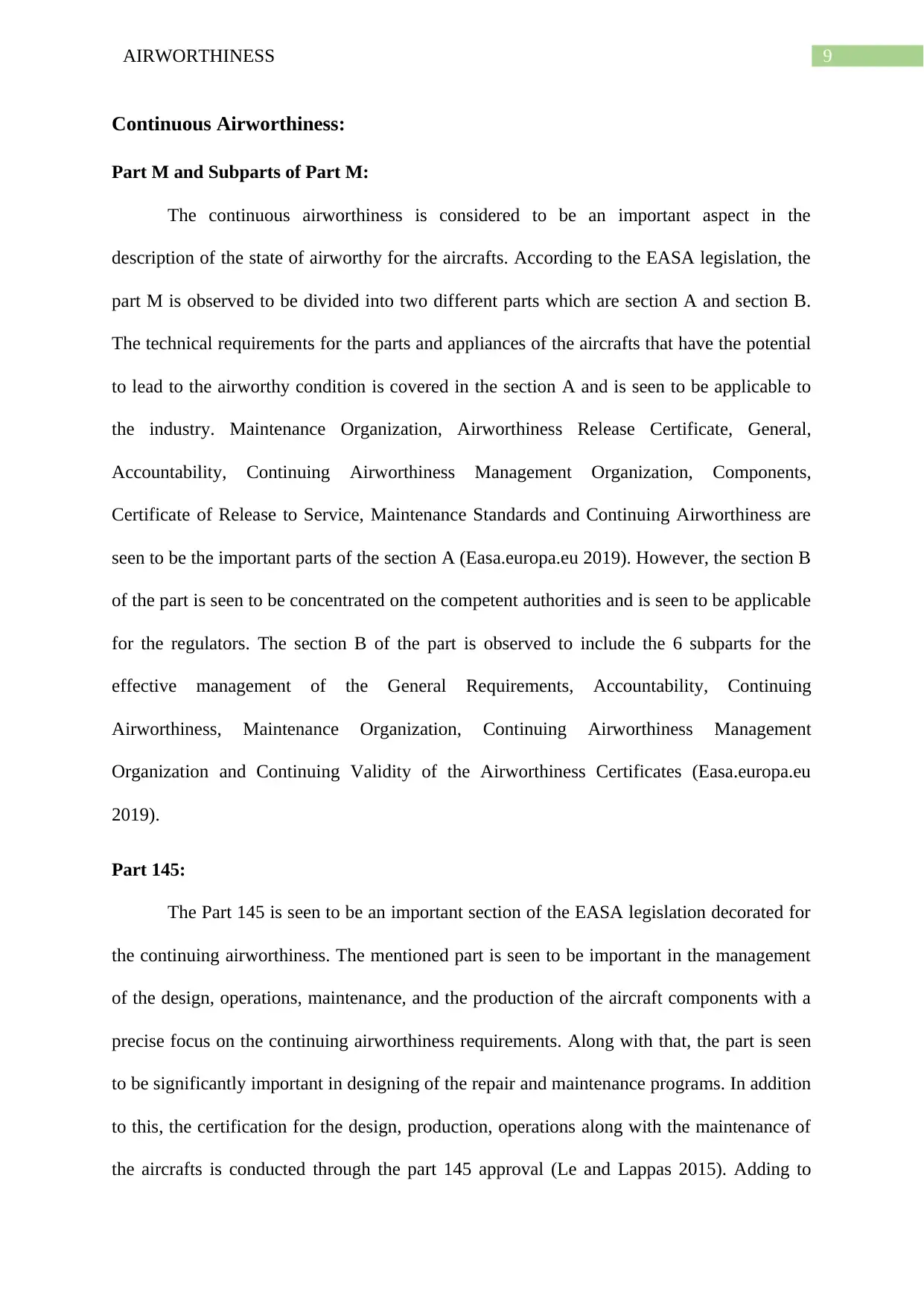
9AIRWORTHINESS
Continuous Airworthiness:
Part M and Subparts of Part M:
The continuous airworthiness is considered to be an important aspect in the
description of the state of airworthy for the aircrafts. According to the EASA legislation, the
part M is observed to be divided into two different parts which are section A and section B.
The technical requirements for the parts and appliances of the aircrafts that have the potential
to lead to the airworthy condition is covered in the section A and is seen to be applicable to
the industry. Maintenance Organization, Airworthiness Release Certificate, General,
Accountability, Continuing Airworthiness Management Organization, Components,
Certificate of Release to Service, Maintenance Standards and Continuing Airworthiness are
seen to be the important parts of the section A (Easa.europa.eu 2019). However, the section B
of the part is seen to be concentrated on the competent authorities and is seen to be applicable
for the regulators. The section B of the part is observed to include the 6 subparts for the
effective management of the General Requirements, Accountability, Continuing
Airworthiness, Maintenance Organization, Continuing Airworthiness Management
Organization and Continuing Validity of the Airworthiness Certificates (Easa.europa.eu
2019).
Part 145:
The Part 145 is seen to be an important section of the EASA legislation decorated for
the continuing airworthiness. The mentioned part is seen to be important in the management
of the design, operations, maintenance, and the production of the aircraft components with a
precise focus on the continuing airworthiness requirements. Along with that, the part is seen
to be significantly important in designing of the repair and maintenance programs. In addition
to this, the certification for the design, production, operations along with the maintenance of
the aircrafts is conducted through the part 145 approval (Le and Lappas 2015). Adding to
Continuous Airworthiness:
Part M and Subparts of Part M:
The continuous airworthiness is considered to be an important aspect in the
description of the state of airworthy for the aircrafts. According to the EASA legislation, the
part M is observed to be divided into two different parts which are section A and section B.
The technical requirements for the parts and appliances of the aircrafts that have the potential
to lead to the airworthy condition is covered in the section A and is seen to be applicable to
the industry. Maintenance Organization, Airworthiness Release Certificate, General,
Accountability, Continuing Airworthiness Management Organization, Components,
Certificate of Release to Service, Maintenance Standards and Continuing Airworthiness are
seen to be the important parts of the section A (Easa.europa.eu 2019). However, the section B
of the part is seen to be concentrated on the competent authorities and is seen to be applicable
for the regulators. The section B of the part is observed to include the 6 subparts for the
effective management of the General Requirements, Accountability, Continuing
Airworthiness, Maintenance Organization, Continuing Airworthiness Management
Organization and Continuing Validity of the Airworthiness Certificates (Easa.europa.eu
2019).
Part 145:
The Part 145 is seen to be an important section of the EASA legislation decorated for
the continuing airworthiness. The mentioned part is seen to be important in the management
of the design, operations, maintenance, and the production of the aircraft components with a
precise focus on the continuing airworthiness requirements. Along with that, the part is seen
to be significantly important in designing of the repair and maintenance programs. In addition
to this, the certification for the design, production, operations along with the maintenance of
the aircrafts is conducted through the part 145 approval (Le and Lappas 2015). Adding to
Paraphrase This Document
Need a fresh take? Get an instant paraphrase of this document with our AI Paraphraser
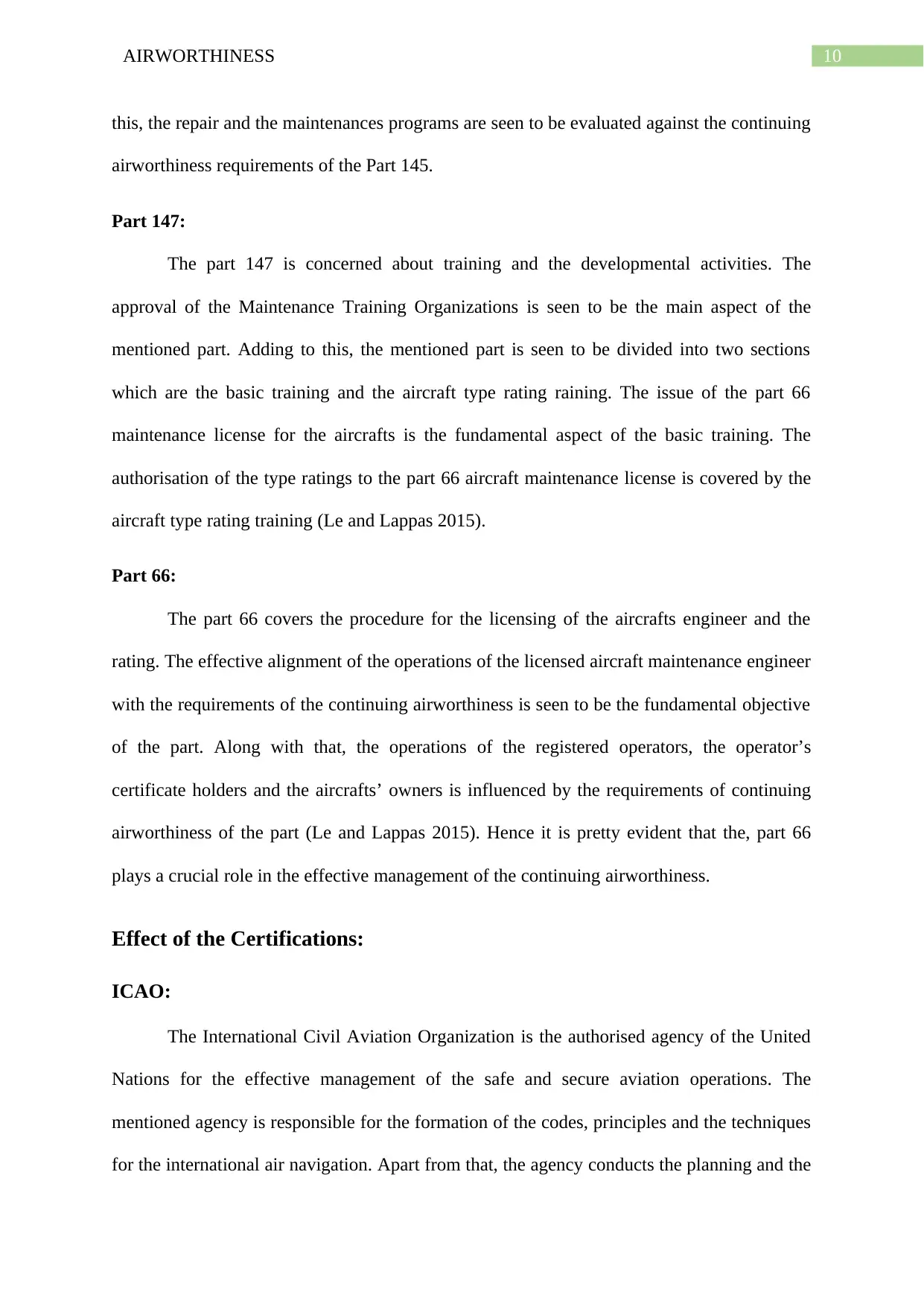
10AIRWORTHINESS
this, the repair and the maintenances programs are seen to be evaluated against the continuing
airworthiness requirements of the Part 145.
Part 147:
The part 147 is concerned about training and the developmental activities. The
approval of the Maintenance Training Organizations is seen to be the main aspect of the
mentioned part. Adding to this, the mentioned part is seen to be divided into two sections
which are the basic training and the aircraft type rating raining. The issue of the part 66
maintenance license for the aircrafts is the fundamental aspect of the basic training. The
authorisation of the type ratings to the part 66 aircraft maintenance license is covered by the
aircraft type rating training (Le and Lappas 2015).
Part 66:
The part 66 covers the procedure for the licensing of the aircrafts engineer and the
rating. The effective alignment of the operations of the licensed aircraft maintenance engineer
with the requirements of the continuing airworthiness is seen to be the fundamental objective
of the part. Along with that, the operations of the registered operators, the operator’s
certificate holders and the aircrafts’ owners is influenced by the requirements of continuing
airworthiness of the part (Le and Lappas 2015). Hence it is pretty evident that the, part 66
plays a crucial role in the effective management of the continuing airworthiness.
Effect of the Certifications:
ICAO:
The International Civil Aviation Organization is the authorised agency of the United
Nations for the effective management of the safe and secure aviation operations. The
mentioned agency is responsible for the formation of the codes, principles and the techniques
for the international air navigation. Apart from that, the agency conducts the planning and the
this, the repair and the maintenances programs are seen to be evaluated against the continuing
airworthiness requirements of the Part 145.
Part 147:
The part 147 is concerned about training and the developmental activities. The
approval of the Maintenance Training Organizations is seen to be the main aspect of the
mentioned part. Adding to this, the mentioned part is seen to be divided into two sections
which are the basic training and the aircraft type rating raining. The issue of the part 66
maintenance license for the aircrafts is the fundamental aspect of the basic training. The
authorisation of the type ratings to the part 66 aircraft maintenance license is covered by the
aircraft type rating training (Le and Lappas 2015).
Part 66:
The part 66 covers the procedure for the licensing of the aircrafts engineer and the
rating. The effective alignment of the operations of the licensed aircraft maintenance engineer
with the requirements of the continuing airworthiness is seen to be the fundamental objective
of the part. Along with that, the operations of the registered operators, the operator’s
certificate holders and the aircrafts’ owners is influenced by the requirements of continuing
airworthiness of the part (Le and Lappas 2015). Hence it is pretty evident that the, part 66
plays a crucial role in the effective management of the continuing airworthiness.
Effect of the Certifications:
ICAO:
The International Civil Aviation Organization is the authorised agency of the United
Nations for the effective management of the safe and secure aviation operations. The
mentioned agency is responsible for the formation of the codes, principles and the techniques
for the international air navigation. Apart from that, the agency conducts the planning and the
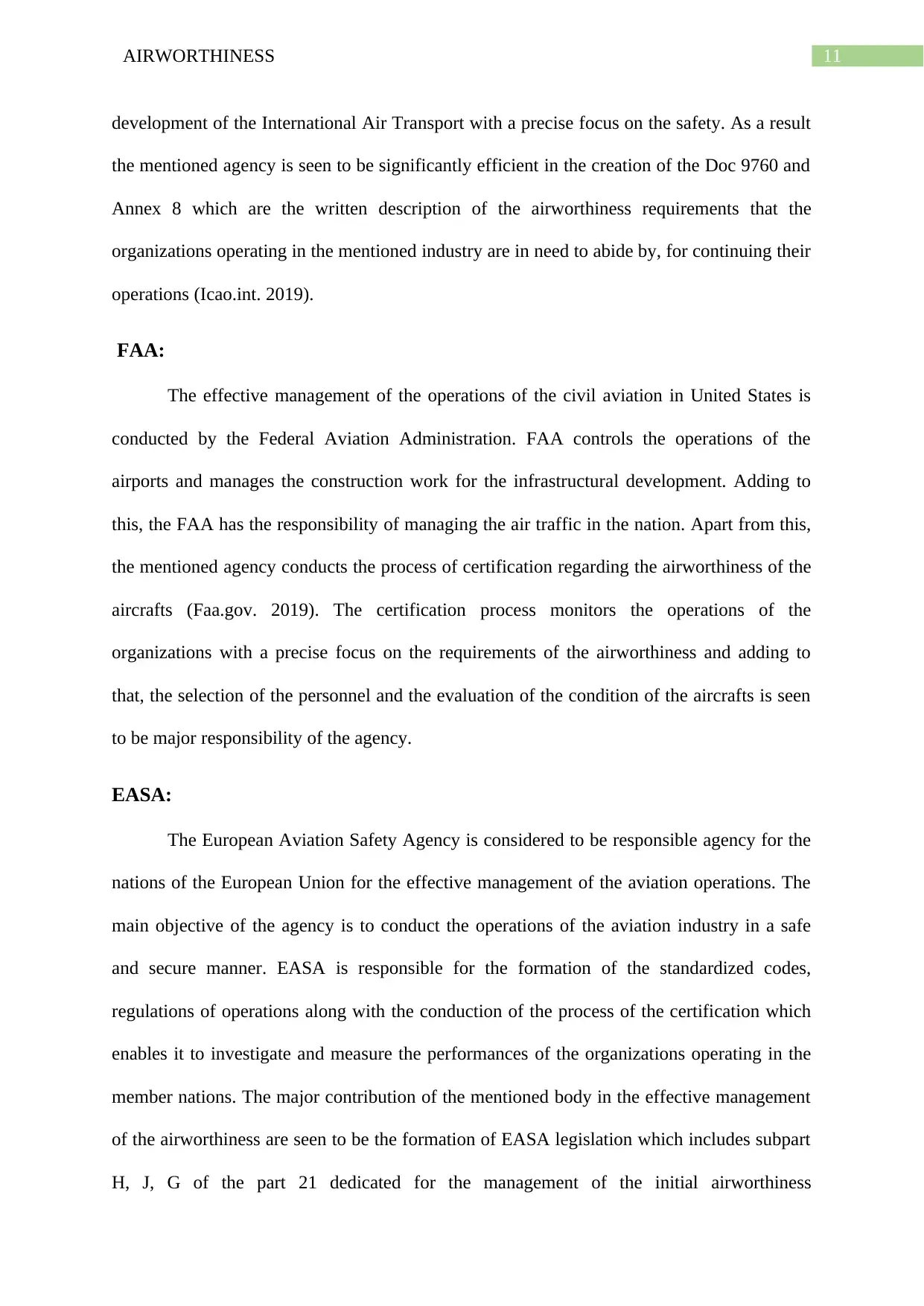
11AIRWORTHINESS
development of the International Air Transport with a precise focus on the safety. As a result
the mentioned agency is seen to be significantly efficient in the creation of the Doc 9760 and
Annex 8 which are the written description of the airworthiness requirements that the
organizations operating in the mentioned industry are in need to abide by, for continuing their
operations (Icao.int. 2019).
FAA:
The effective management of the operations of the civil aviation in United States is
conducted by the Federal Aviation Administration. FAA controls the operations of the
airports and manages the construction work for the infrastructural development. Adding to
this, the FAA has the responsibility of managing the air traffic in the nation. Apart from this,
the mentioned agency conducts the process of certification regarding the airworthiness of the
aircrafts (Faa.gov. 2019). The certification process monitors the operations of the
organizations with a precise focus on the requirements of the airworthiness and adding to
that, the selection of the personnel and the evaluation of the condition of the aircrafts is seen
to be major responsibility of the agency.
EASA:
The European Aviation Safety Agency is considered to be responsible agency for the
nations of the European Union for the effective management of the aviation operations. The
main objective of the agency is to conduct the operations of the aviation industry in a safe
and secure manner. EASA is responsible for the formation of the standardized codes,
regulations of operations along with the conduction of the process of the certification which
enables it to investigate and measure the performances of the organizations operating in the
member nations. The major contribution of the mentioned body in the effective management
of the airworthiness are seen to be the formation of EASA legislation which includes subpart
H, J, G of the part 21 dedicated for the management of the initial airworthiness
development of the International Air Transport with a precise focus on the safety. As a result
the mentioned agency is seen to be significantly efficient in the creation of the Doc 9760 and
Annex 8 which are the written description of the airworthiness requirements that the
organizations operating in the mentioned industry are in need to abide by, for continuing their
operations (Icao.int. 2019).
FAA:
The effective management of the operations of the civil aviation in United States is
conducted by the Federal Aviation Administration. FAA controls the operations of the
airports and manages the construction work for the infrastructural development. Adding to
this, the FAA has the responsibility of managing the air traffic in the nation. Apart from this,
the mentioned agency conducts the process of certification regarding the airworthiness of the
aircrafts (Faa.gov. 2019). The certification process monitors the operations of the
organizations with a precise focus on the requirements of the airworthiness and adding to
that, the selection of the personnel and the evaluation of the condition of the aircrafts is seen
to be major responsibility of the agency.
EASA:
The European Aviation Safety Agency is considered to be responsible agency for the
nations of the European Union for the effective management of the aviation operations. The
main objective of the agency is to conduct the operations of the aviation industry in a safe
and secure manner. EASA is responsible for the formation of the standardized codes,
regulations of operations along with the conduction of the process of the certification which
enables it to investigate and measure the performances of the organizations operating in the
member nations. The major contribution of the mentioned body in the effective management
of the airworthiness are seen to be the formation of EASA legislation which includes subpart
H, J, G of the part 21 dedicated for the management of the initial airworthiness
⊘ This is a preview!⊘
Do you want full access?
Subscribe today to unlock all pages.

Trusted by 1+ million students worldwide
1 out of 27
Related Documents
Your All-in-One AI-Powered Toolkit for Academic Success.
+13062052269
info@desklib.com
Available 24*7 on WhatsApp / Email
![[object Object]](/_next/static/media/star-bottom.7253800d.svg)
Unlock your academic potential
Copyright © 2020–2025 A2Z Services. All Rights Reserved. Developed and managed by ZUCOL.





